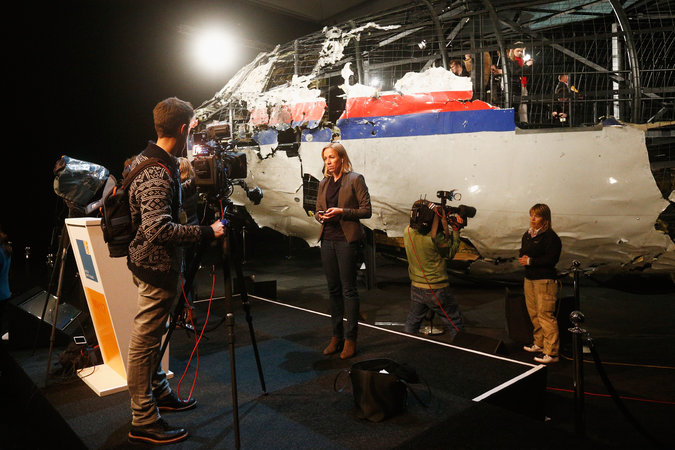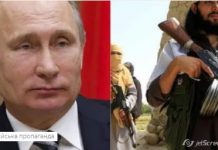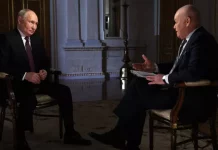
On Tuesday, the Dutch Safety Board issued its long-awaited report on what brought down Malaysia Airlines Flight 17 in eastern Ukraine on July 17, 2014. Speaking at Gilze-Rijen Air Base in the Netherlands, Tjibbe Joustra, the safety board’s chairman, announced that after meticulous study — including the plastering the charred scraps of the plane onto a skeleton model of the Boeing 777, which sat behind him as he spoke — the board concluded that the plane was brought down by a missile from the Russian-made 9M38 series, fired from a Buk surface-to-air missile system in eastern Ukraine. It exploded less than a yard from the left side of the plane’s cockpit. The high-energy fragments flung out by the missile perforated the plane’s nose and caused it to tear off, leading to the breakup and crash of the plane about a minute later, which killed all 298 passengers onboard.
The report didn’t tell us anything we didn’t already know or strongly suspect: that the cause of the crash was a Russian-made missile fired from an area hotly contested between Russian-backed separatists and the Ukrainian military, killing hundreds of people who had nothing to do with the conflict. Though the report didn’t specify who fired the missile, Joustra said it was launched from rebel-held territory. This was, again, what we already suspected — and a scenario for which independent outfits, like the citizen-journalism website Bellingcat, have rustled up much convincing evidence.
A lot, however, comes down to who “us” is here. We in the West saw the presentation of one report, while Russians saw another: Almaz-Antey, the Russian state corporation that produces the Buk systems, held a competing news conference on Tuesday in Moscow, featuring its own report. Almaz-Antey’s accounting of the incident, which included footage of an exploding missile near the nose of a decommissioned Russian plane, reached subtly different conclusions. Sure, it was a Russian-made Buk that downed the plane, Almaz-Antey’s director Yan Novikov said, but those missiles have not been in use in Russia since 2011. Moreover, Novikov said, it was fired not from Snizhne, in rebel-held territory, but from near Zaroschenskoe, which was held by the Ukrainian Army. Novikov’s conclusion? Those 298 people were killed not by Russians, but by Ukrainians.
There’s a lot riding on this conclusion — for instance, the costly Western sanctions imposed on Russia in the wake of the crash. And so, from the day the pieces of the plane rained down on Ukraine’s sunflower fields, Moscow has advanced its own theories about what brought down Malaysia Airlines Flight 17. From early claims that it was a Ukrainian attempt to bring down Vladimir Putin’s presidential plane to later, more technical explanations, the Russian media and Almaz-Antey have acted like defense attorneys in a criminal trial, deliberately muddying the waters, fastidiously creating as much reasonable doubt as possible to lead the scent away from their client.
The Dutch report implicitly fingers the Russians, but Kremlin-friendly newspapers have seized on stray details, like the report’s criticism of the Ukrainian government for not shutting down airspace over the conflict, and the big question it chose not to directly answer: Who fired the missile? (Determining ultimate responsibility, the authors of the report said, “falls outside the mandate of the Dutch Safety Board.”) The evening news across Russia showed not the Dutch news conference but the Moscow one, in which the reporter concluded that the Western version of events “doesn’t hold water.”
Given that 94 percent of Russians consider television their main source of news, and that 67 percent consider it a source of useful and objective information, it is no surprise that Russians have a radically different picture of what happened to the plane than their Western counterparts.
Polled in the days after the catastrophe, 46 percent of Russians said Flight 17 was felled by a Ukrainian antiaircraft system, and 36 percent believed it was the work of a Ukrainian jet — both versions that were heavily pushed by the Russian media in the immediate wake of the disaster. Only 3 percent believed it was shot down by separatists. A year later, that picture hasn’t changed much. Forty-four percent believe it was shot down by the Ukrainian military, 17 percent by the Americans. Again, only 3 percent blamed the separatists. That is, the version of events that is generally accepted in the West is shared by only 3 percent of Russians.
Put another way: Propaganda works. Putin has understood that from Day 1. Fifteen years ago, one of his first acts as president of the Russian Federation was to seize control of television and bring it under the authority of the state. (The saga is masterfully detailed in “Kremlin Rising,” the 2005 book by Susan Glasser and Peter Baker.) Controlling the television screen means controlling the reality that his subjects inhabit, and it has proved to be the most important bulwark of Putin’s hold on power. A week ago, when Russia began its air campaign in Syria, only 14 percent of Russians supported military intervention. A week of intense television programming later, only 28 percent oppose it.
Most Russians live in a reality parallel to the West, and this presents a serious political challenge. Sanctioning Moscow for downing a plane most Russians believe the Ukrainians shot down only makes them rally behind a leader they believe is unfairly targeted by Washington and Brussels. It has also made it easy for Moscow to blame Russia’s cratering economy not on its own bad management and metastatic corruption but on unjust Western sanctions.
Washington going after Putin for attacking non-Islamic State rebels in Syria only plays into Putin’s hands: If Russian citizens believe that Moscow is bombing the Islamic State, but that Washington is against it, does that mean that Washington is behind the Islamic State? Not surprisingly, versions of this theory have also blanketed the Russian media. It is also why Putin continues to enjoy such deliriously high approval ratings. They may be inexplicable to a Western audience, which uniformly sees Putin portrayed as a latter-day Bond villain, but to a Russian viewer who sees only the strength and sagacity of Putin splashed across his screen every night, what’s not to like?
Western Cold Warriors understood the importance of getting their own version of events to Russians, which is how Radio Free Europe and Voice of America were born. But today, those outlets are widely seen as ineffective, shrill government propaganda, even by that receptive 3 percent of westernized Russians who think that Russian-backed rebels brought down Flight 17. This is supposed to be the age of fragmented, unfiltered, self-tailored information, and yet Putin still manages to hold his people’s gaze — and practically remove them from the political decision-making process — through one of the most traditional media. The West can’t seem to puncture Russian television’s hermetic seal, or understand what Putin has always known: The boob tube is the key to the kingdom.
By Julia Ioffe, The New York Times Magazine





